University Workplace Learning Environment Assignment Solution
VerifiedAdded on 2022/12/27
|8
|1446
|64
Homework Assignment
AI Summary
This document presents a comprehensive solution to an assignment focused on developing a workplace learning environment, likely for a course such as BSBLED501. The solution addresses key aspects of fostering a positive learning culture, including the application of the Kirkpatrick model to assess training effectiveness, the importance of cross-training and diverse learning plans, and strategies for aligning individual, team, and organizational learning objectives. It explores the role of employee assistance programs, the significance of establishing clear goals, and the impact of rewards, recognition, and leadership by example in promoting job satisfaction and continuous improvement. The solution also covers formal and informal learning opportunities, need analysis, feedback mechanisms, and strategies for encouraging employee participation. The assignment emphasizes practical steps, such as developing individual learning plans, and explores various methods for rewarding and recognizing workplace learning, referencing key literature to support its claims.
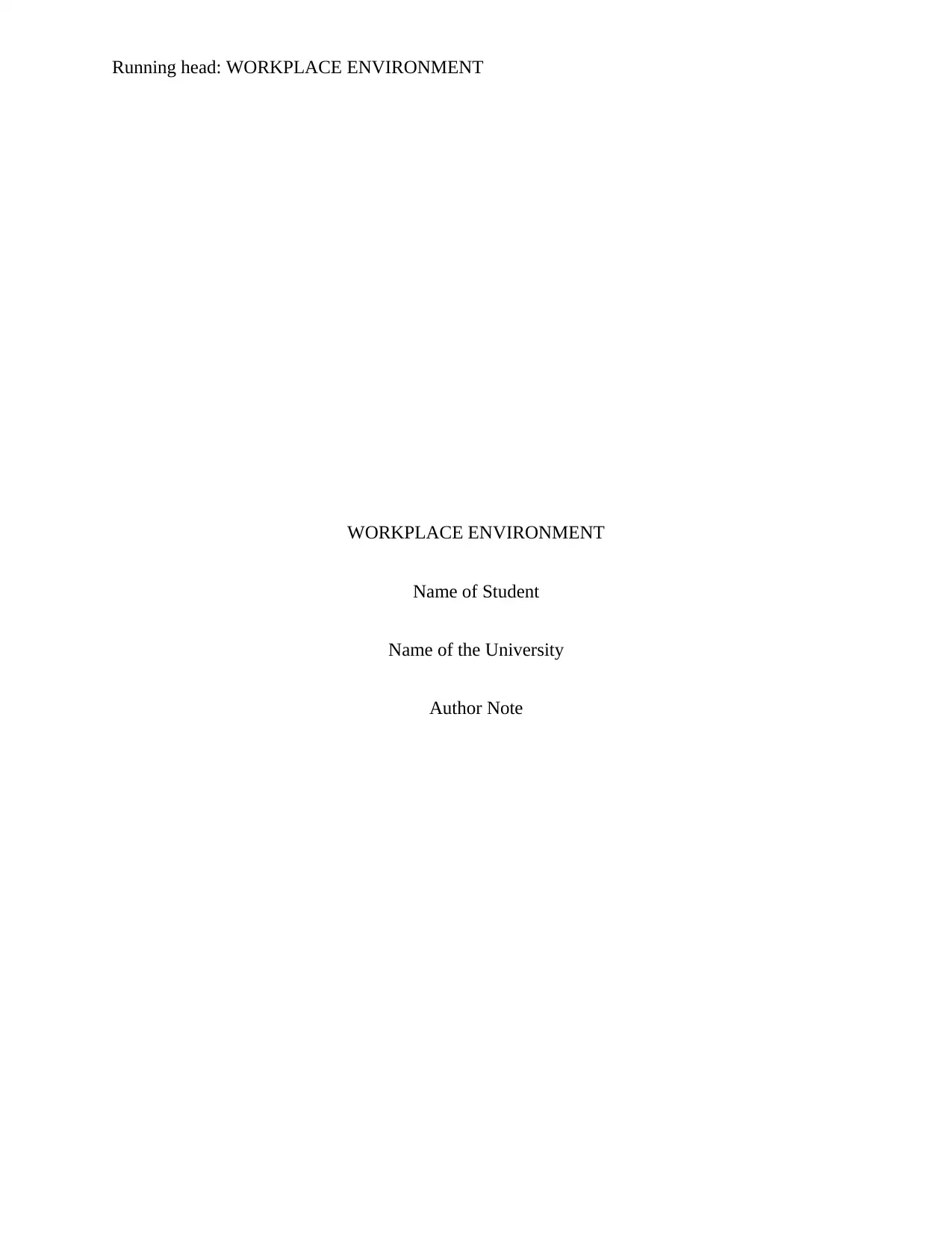
Running head: WORKPLACE ENVIRONMENT
WORKPLACE ENVIRONMENT
Name of Student
Name of the University
Author Note
WORKPLACE ENVIRONMENT
Name of Student
Name of the University
Author Note
Paraphrase This Document
Need a fresh take? Get an instant paraphrase of this document with our AI Paraphraser
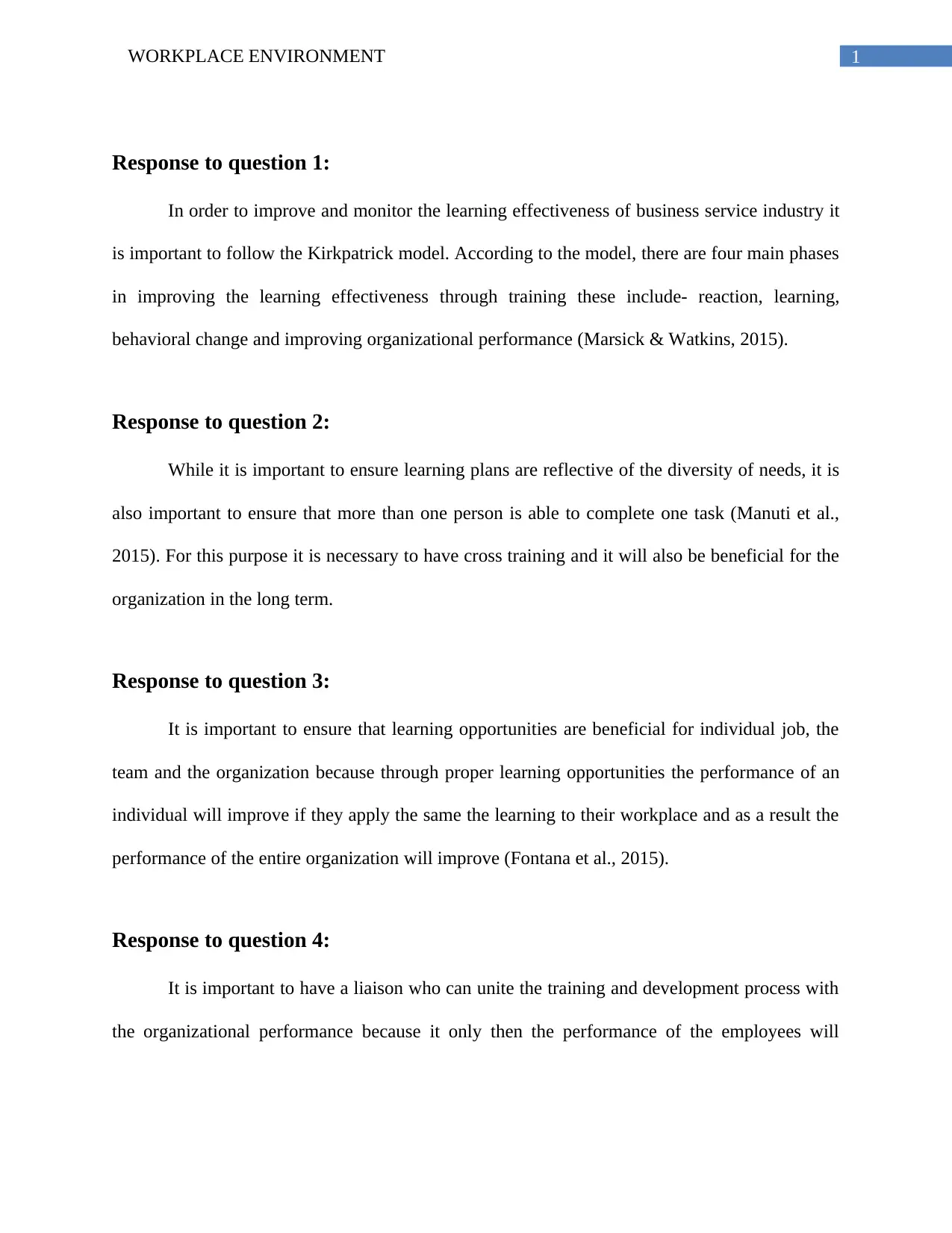
1WORKPLACE ENVIRONMENT
Response to question 1:
In order to improve and monitor the learning effectiveness of business service industry it
is important to follow the Kirkpatrick model. According to the model, there are four main phases
in improving the learning effectiveness through training these include- reaction, learning,
behavioral change and improving organizational performance (Marsick & Watkins, 2015).
Response to question 2:
While it is important to ensure learning plans are reflective of the diversity of needs, it is
also important to ensure that more than one person is able to complete one task (Manuti et al.,
2015). For this purpose it is necessary to have cross training and it will also be beneficial for the
organization in the long term.
Response to question 3:
It is important to ensure that learning opportunities are beneficial for individual job, the
team and the organization because through proper learning opportunities the performance of an
individual will improve if they apply the same the learning to their workplace and as a result the
performance of the entire organization will improve (Fontana et al., 2015).
Response to question 4:
It is important to have a liaison who can unite the training and development process with
the organizational performance because it only then the performance of the employees will
Response to question 1:
In order to improve and monitor the learning effectiveness of business service industry it
is important to follow the Kirkpatrick model. According to the model, there are four main phases
in improving the learning effectiveness through training these include- reaction, learning,
behavioral change and improving organizational performance (Marsick & Watkins, 2015).
Response to question 2:
While it is important to ensure learning plans are reflective of the diversity of needs, it is
also important to ensure that more than one person is able to complete one task (Manuti et al.,
2015). For this purpose it is necessary to have cross training and it will also be beneficial for the
organization in the long term.
Response to question 3:
It is important to ensure that learning opportunities are beneficial for individual job, the
team and the organization because through proper learning opportunities the performance of an
individual will improve if they apply the same the learning to their workplace and as a result the
performance of the entire organization will improve (Fontana et al., 2015).
Response to question 4:
It is important to have a liaison who can unite the training and development process with
the organizational performance because it only then the performance of the employees will
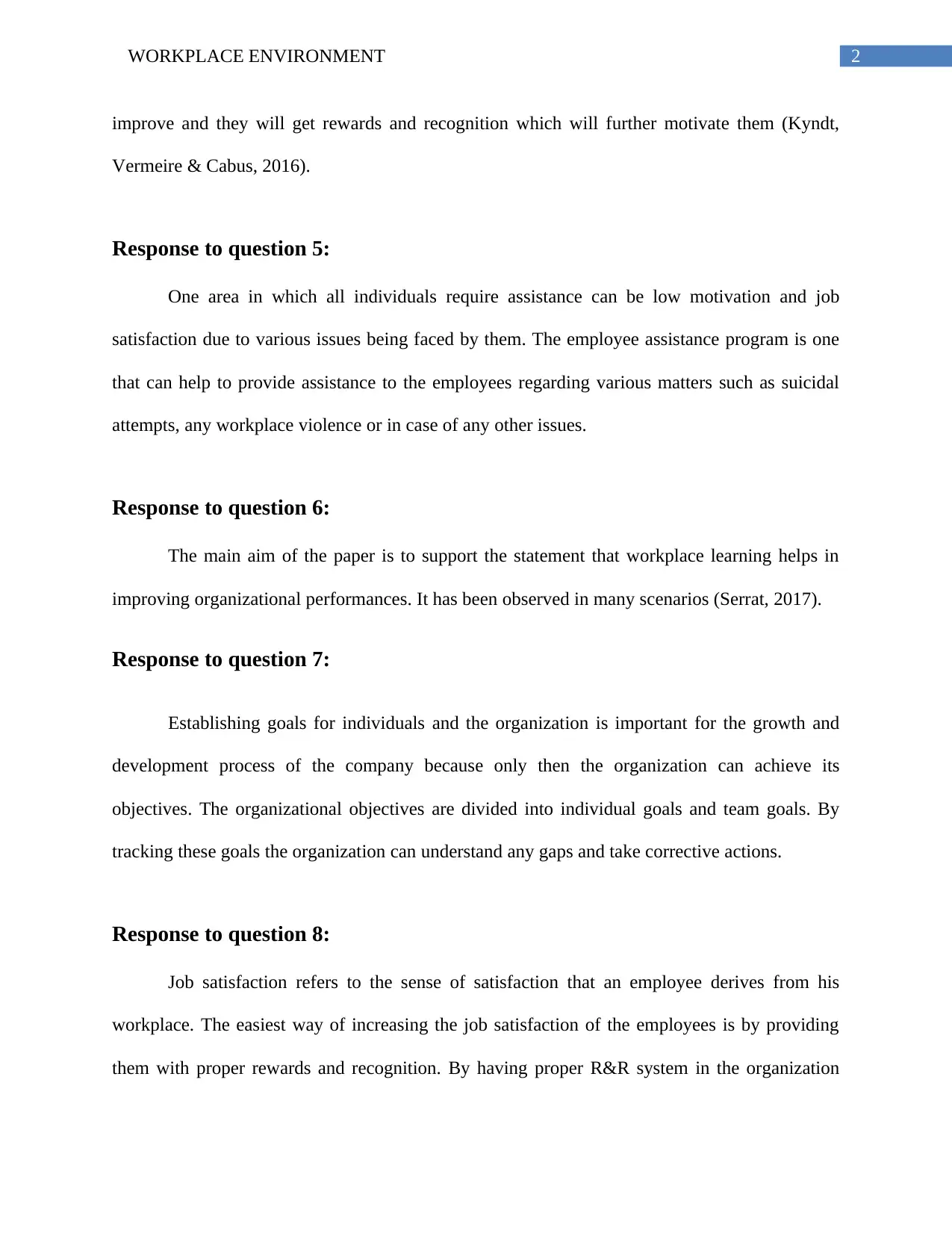
2WORKPLACE ENVIRONMENT
improve and they will get rewards and recognition which will further motivate them (Kyndt,
Vermeire & Cabus, 2016).
Response to question 5:
One area in which all individuals require assistance can be low motivation and job
satisfaction due to various issues being faced by them. The employee assistance program is one
that can help to provide assistance to the employees regarding various matters such as suicidal
attempts, any workplace violence or in case of any other issues.
Response to question 6:
The main aim of the paper is to support the statement that workplace learning helps in
improving organizational performances. It has been observed in many scenarios (Serrat, 2017).
Response to question 7:
Establishing goals for individuals and the organization is important for the growth and
development process of the company because only then the organization can achieve its
objectives. The organizational objectives are divided into individual goals and team goals. By
tracking these goals the organization can understand any gaps and take corrective actions.
Response to question 8:
Job satisfaction refers to the sense of satisfaction that an employee derives from his
workplace. The easiest way of increasing the job satisfaction of the employees is by providing
them with proper rewards and recognition. By having proper R&R system in the organization
improve and they will get rewards and recognition which will further motivate them (Kyndt,
Vermeire & Cabus, 2016).
Response to question 5:
One area in which all individuals require assistance can be low motivation and job
satisfaction due to various issues being faced by them. The employee assistance program is one
that can help to provide assistance to the employees regarding various matters such as suicidal
attempts, any workplace violence or in case of any other issues.
Response to question 6:
The main aim of the paper is to support the statement that workplace learning helps in
improving organizational performances. It has been observed in many scenarios (Serrat, 2017).
Response to question 7:
Establishing goals for individuals and the organization is important for the growth and
development process of the company because only then the organization can achieve its
objectives. The organizational objectives are divided into individual goals and team goals. By
tracking these goals the organization can understand any gaps and take corrective actions.
Response to question 8:
Job satisfaction refers to the sense of satisfaction that an employee derives from his
workplace. The easiest way of increasing the job satisfaction of the employees is by providing
them with proper rewards and recognition. By having proper R&R system in the organization
⊘ This is a preview!⊘
Do you want full access?
Subscribe today to unlock all pages.

Trusted by 1+ million students worldwide
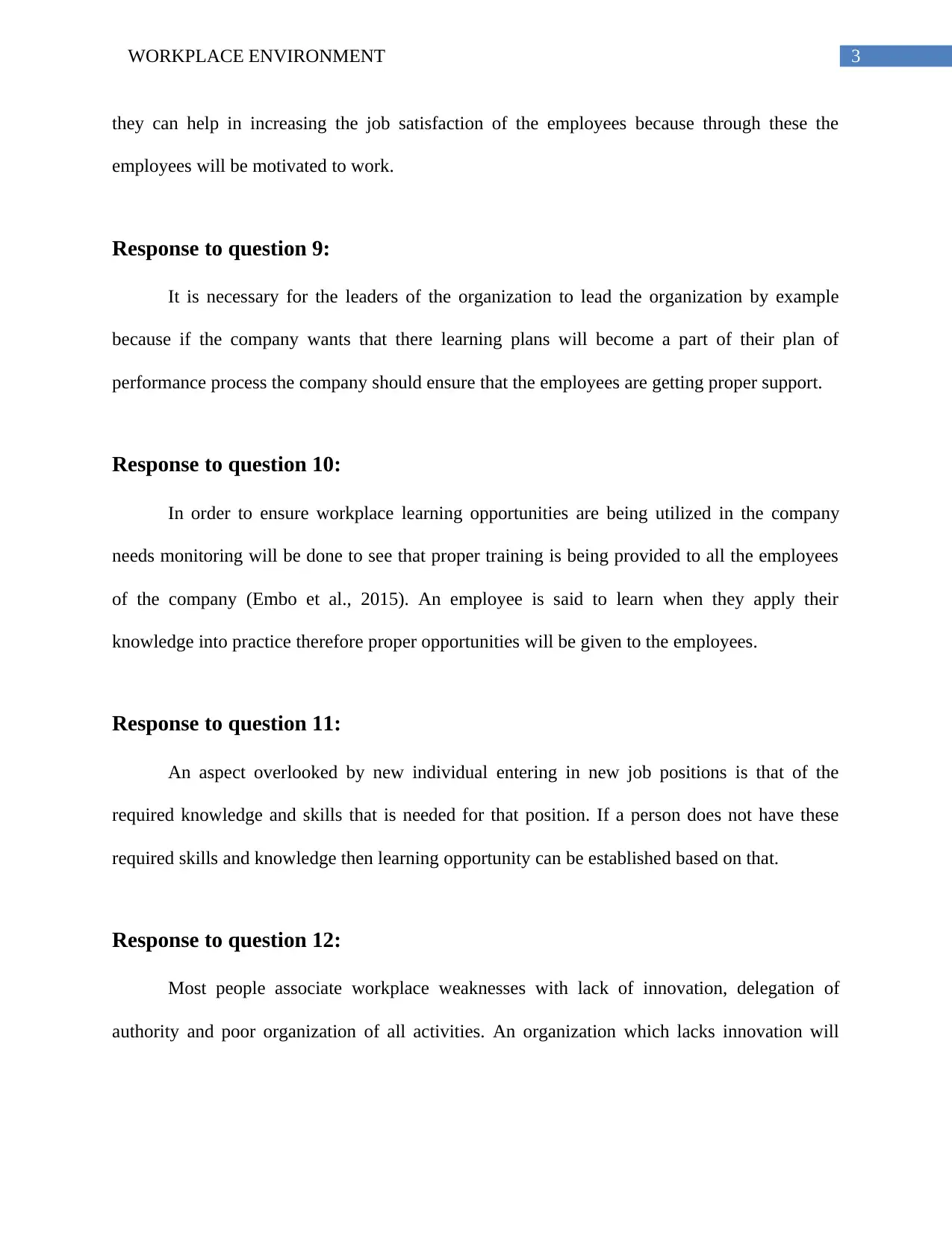
3WORKPLACE ENVIRONMENT
they can help in increasing the job satisfaction of the employees because through these the
employees will be motivated to work.
Response to question 9:
It is necessary for the leaders of the organization to lead the organization by example
because if the company wants that there learning plans will become a part of their plan of
performance process the company should ensure that the employees are getting proper support.
Response to question 10:
In order to ensure workplace learning opportunities are being utilized in the company
needs monitoring will be done to see that proper training is being provided to all the employees
of the company (Embo et al., 2015). An employee is said to learn when they apply their
knowledge into practice therefore proper opportunities will be given to the employees.
Response to question 11:
An aspect overlooked by new individual entering in new job positions is that of the
required knowledge and skills that is needed for that position. If a person does not have these
required skills and knowledge then learning opportunity can be established based on that.
Response to question 12:
Most people associate workplace weaknesses with lack of innovation, delegation of
authority and poor organization of all activities. An organization which lacks innovation will
they can help in increasing the job satisfaction of the employees because through these the
employees will be motivated to work.
Response to question 9:
It is necessary for the leaders of the organization to lead the organization by example
because if the company wants that there learning plans will become a part of their plan of
performance process the company should ensure that the employees are getting proper support.
Response to question 10:
In order to ensure workplace learning opportunities are being utilized in the company
needs monitoring will be done to see that proper training is being provided to all the employees
of the company (Embo et al., 2015). An employee is said to learn when they apply their
knowledge into practice therefore proper opportunities will be given to the employees.
Response to question 11:
An aspect overlooked by new individual entering in new job positions is that of the
required knowledge and skills that is needed for that position. If a person does not have these
required skills and knowledge then learning opportunity can be established based on that.
Response to question 12:
Most people associate workplace weaknesses with lack of innovation, delegation of
authority and poor organization of all activities. An organization which lacks innovation will
Paraphrase This Document
Need a fresh take? Get an instant paraphrase of this document with our AI Paraphraser
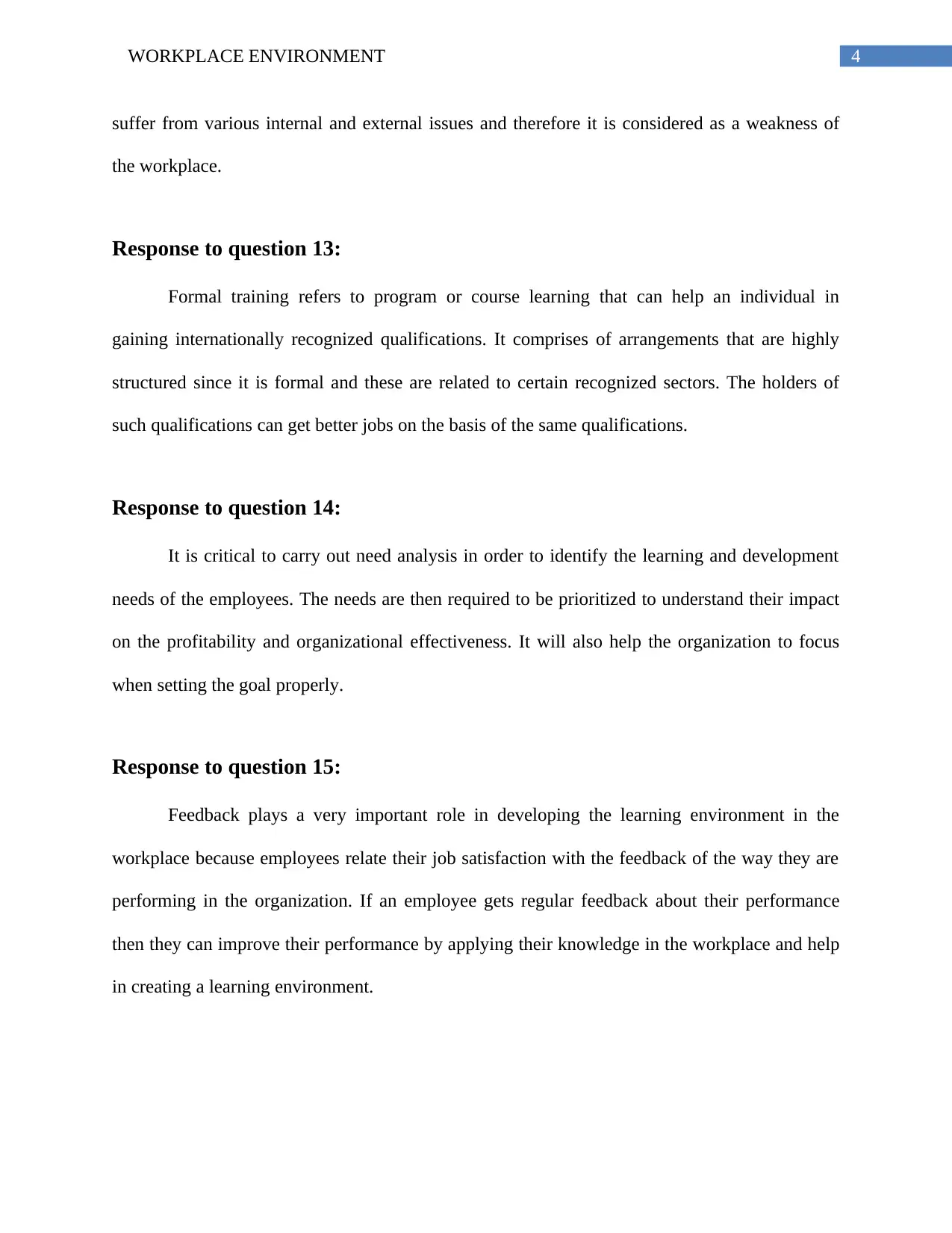
4WORKPLACE ENVIRONMENT
suffer from various internal and external issues and therefore it is considered as a weakness of
the workplace.
Response to question 13:
Formal training refers to program or course learning that can help an individual in
gaining internationally recognized qualifications. It comprises of arrangements that are highly
structured since it is formal and these are related to certain recognized sectors. The holders of
such qualifications can get better jobs on the basis of the same qualifications.
Response to question 14:
It is critical to carry out need analysis in order to identify the learning and development
needs of the employees. The needs are then required to be prioritized to understand their impact
on the profitability and organizational effectiveness. It will also help the organization to focus
when setting the goal properly.
Response to question 15:
Feedback plays a very important role in developing the learning environment in the
workplace because employees relate their job satisfaction with the feedback of the way they are
performing in the organization. If an employee gets regular feedback about their performance
then they can improve their performance by applying their knowledge in the workplace and help
in creating a learning environment.
suffer from various internal and external issues and therefore it is considered as a weakness of
the workplace.
Response to question 13:
Formal training refers to program or course learning that can help an individual in
gaining internationally recognized qualifications. It comprises of arrangements that are highly
structured since it is formal and these are related to certain recognized sectors. The holders of
such qualifications can get better jobs on the basis of the same qualifications.
Response to question 14:
It is critical to carry out need analysis in order to identify the learning and development
needs of the employees. The needs are then required to be prioritized to understand their impact
on the profitability and organizational effectiveness. It will also help the organization to focus
when setting the goal properly.
Response to question 15:
Feedback plays a very important role in developing the learning environment in the
workplace because employees relate their job satisfaction with the feedback of the way they are
performing in the organization. If an employee gets regular feedback about their performance
then they can improve their performance by applying their knowledge in the workplace and help
in creating a learning environment.
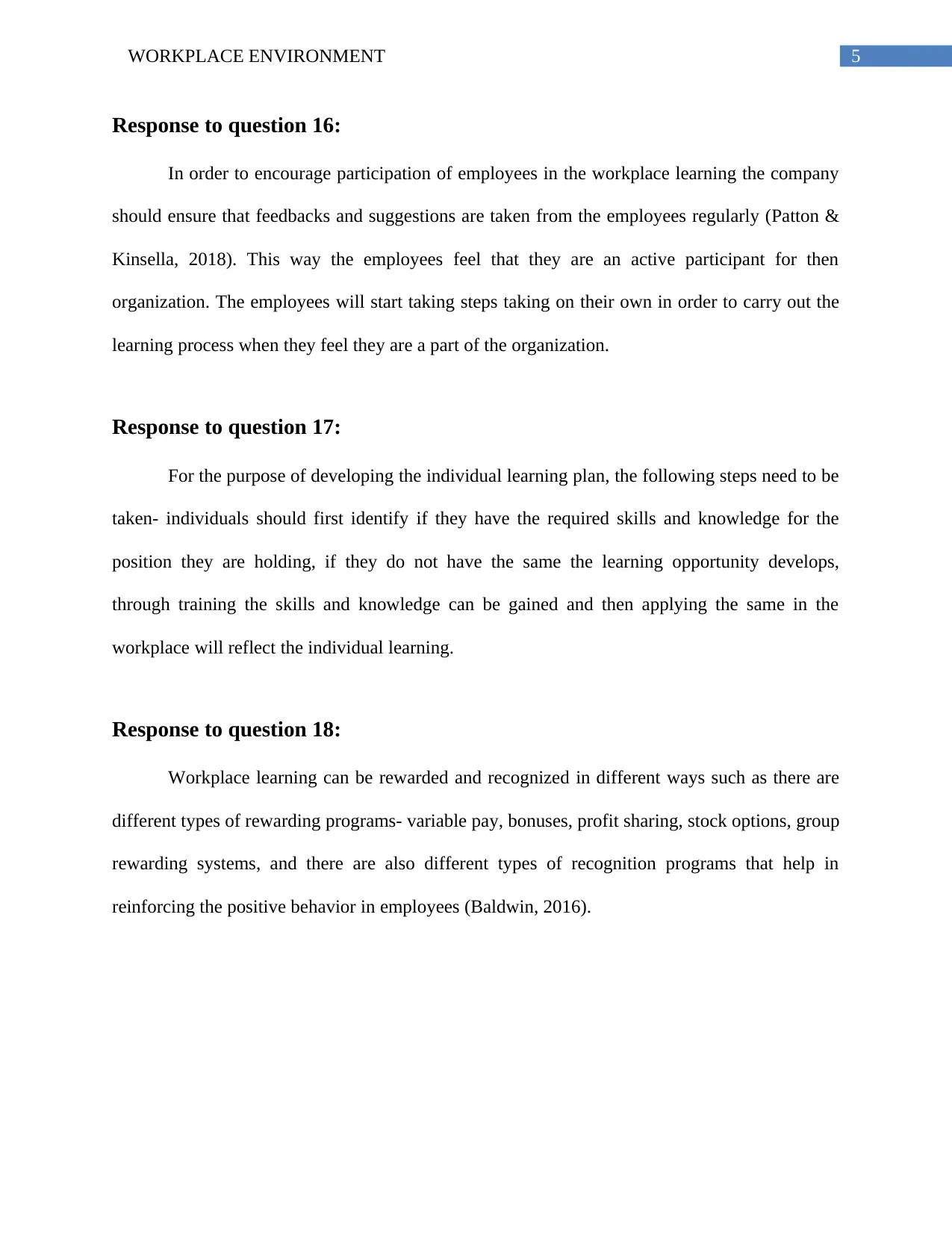
5WORKPLACE ENVIRONMENT
Response to question 16:
In order to encourage participation of employees in the workplace learning the company
should ensure that feedbacks and suggestions are taken from the employees regularly (Patton &
Kinsella, 2018). This way the employees feel that they are an active participant for then
organization. The employees will start taking steps taking on their own in order to carry out the
learning process when they feel they are a part of the organization.
Response to question 17:
For the purpose of developing the individual learning plan, the following steps need to be
taken- individuals should first identify if they have the required skills and knowledge for the
position they are holding, if they do not have the same the learning opportunity develops,
through training the skills and knowledge can be gained and then applying the same in the
workplace will reflect the individual learning.
Response to question 18:
Workplace learning can be rewarded and recognized in different ways such as there are
different types of rewarding programs- variable pay, bonuses, profit sharing, stock options, group
rewarding systems, and there are also different types of recognition programs that help in
reinforcing the positive behavior in employees (Baldwin, 2016).
Response to question 16:
In order to encourage participation of employees in the workplace learning the company
should ensure that feedbacks and suggestions are taken from the employees regularly (Patton &
Kinsella, 2018). This way the employees feel that they are an active participant for then
organization. The employees will start taking steps taking on their own in order to carry out the
learning process when they feel they are a part of the organization.
Response to question 17:
For the purpose of developing the individual learning plan, the following steps need to be
taken- individuals should first identify if they have the required skills and knowledge for the
position they are holding, if they do not have the same the learning opportunity develops,
through training the skills and knowledge can be gained and then applying the same in the
workplace will reflect the individual learning.
Response to question 18:
Workplace learning can be rewarded and recognized in different ways such as there are
different types of rewarding programs- variable pay, bonuses, profit sharing, stock options, group
rewarding systems, and there are also different types of recognition programs that help in
reinforcing the positive behavior in employees (Baldwin, 2016).
⊘ This is a preview!⊘
Do you want full access?
Subscribe today to unlock all pages.

Trusted by 1+ million students worldwide
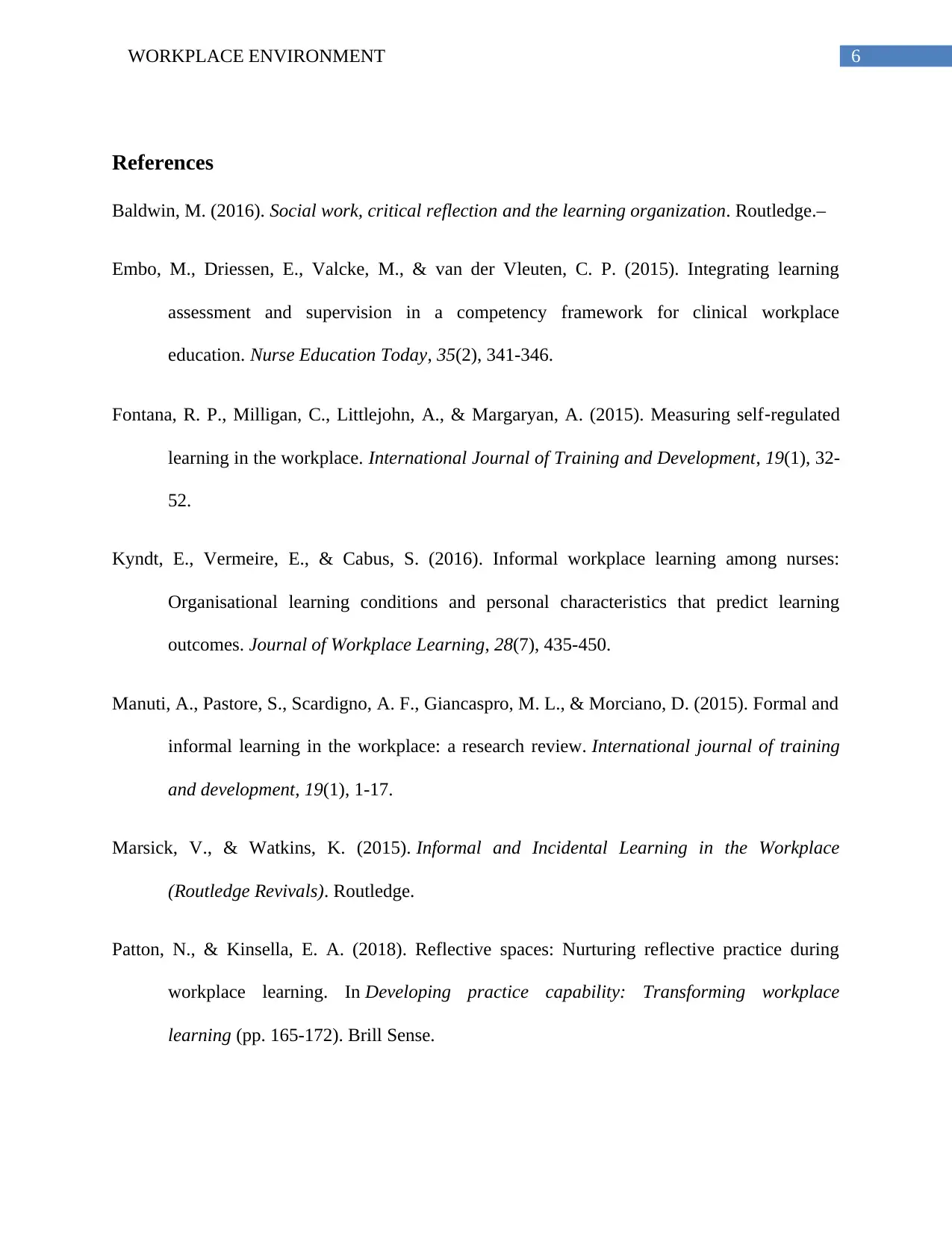
6WORKPLACE ENVIRONMENT
References
Baldwin, M. (2016). Social work, critical reflection and the learning organization. Routledge.–
Embo, M., Driessen, E., Valcke, M., & van der Vleuten, C. P. (2015). Integrating learning
assessment and supervision in a competency framework for clinical workplace
education. Nurse Education Today, 35(2), 341-346.
Fontana, R. P., Milligan, C., Littlejohn, A., & Margaryan, A. (2015). Measuring self‐regulated
learning in the workplace. International Journal of Training and Development, 19(1), 32-
52.
Kyndt, E., Vermeire, E., & Cabus, S. (2016). Informal workplace learning among nurses:
Organisational learning conditions and personal characteristics that predict learning
outcomes. Journal of Workplace Learning, 28(7), 435-450.
Manuti, A., Pastore, S., Scardigno, A. F., Giancaspro, M. L., & Morciano, D. (2015). Formal and
informal learning in the workplace: a research review. International journal of training
and development, 19(1), 1-17.
Marsick, V., & Watkins, K. (2015). Informal and Incidental Learning in the Workplace
(Routledge Revivals). Routledge.
Patton, N., & Kinsella, E. A. (2018). Reflective spaces: Nurturing reflective practice during
workplace learning. In Developing practice capability: Transforming workplace
learning (pp. 165-172). Brill Sense.
References
Baldwin, M. (2016). Social work, critical reflection and the learning organization. Routledge.–
Embo, M., Driessen, E., Valcke, M., & van der Vleuten, C. P. (2015). Integrating learning
assessment and supervision in a competency framework for clinical workplace
education. Nurse Education Today, 35(2), 341-346.
Fontana, R. P., Milligan, C., Littlejohn, A., & Margaryan, A. (2015). Measuring self‐regulated
learning in the workplace. International Journal of Training and Development, 19(1), 32-
52.
Kyndt, E., Vermeire, E., & Cabus, S. (2016). Informal workplace learning among nurses:
Organisational learning conditions and personal characteristics that predict learning
outcomes. Journal of Workplace Learning, 28(7), 435-450.
Manuti, A., Pastore, S., Scardigno, A. F., Giancaspro, M. L., & Morciano, D. (2015). Formal and
informal learning in the workplace: a research review. International journal of training
and development, 19(1), 1-17.
Marsick, V., & Watkins, K. (2015). Informal and Incidental Learning in the Workplace
(Routledge Revivals). Routledge.
Patton, N., & Kinsella, E. A. (2018). Reflective spaces: Nurturing reflective practice during
workplace learning. In Developing practice capability: Transforming workplace
learning (pp. 165-172). Brill Sense.
Paraphrase This Document
Need a fresh take? Get an instant paraphrase of this document with our AI Paraphraser
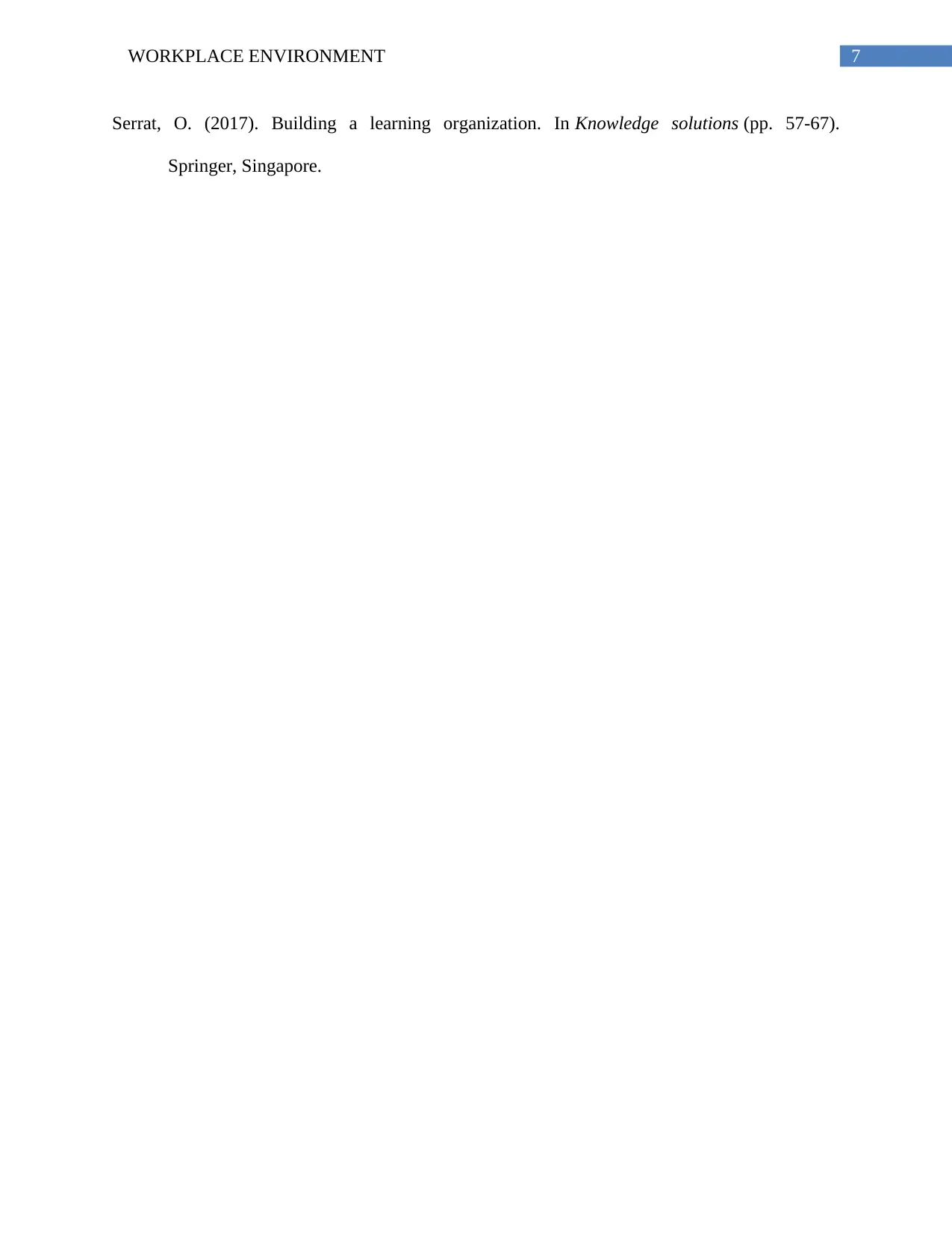
7WORKPLACE ENVIRONMENT
Serrat, O. (2017). Building a learning organization. In Knowledge solutions (pp. 57-67).
Springer, Singapore.
Serrat, O. (2017). Building a learning organization. In Knowledge solutions (pp. 57-67).
Springer, Singapore.
1 out of 8
Related Documents
Your All-in-One AI-Powered Toolkit for Academic Success.
+13062052269
info@desklib.com
Available 24*7 on WhatsApp / Email
![[object Object]](/_next/static/media/star-bottom.7253800d.svg)
Unlock your academic potential
Copyright © 2020–2025 A2Z Services. All Rights Reserved. Developed and managed by ZUCOL.




